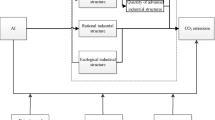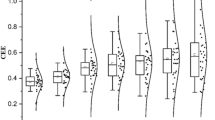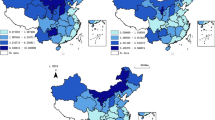Abstract
Artificial intelligence (AI) is a crucial component of sustainable economic development and an indicator of the next wave of technological progress. This study examines the effects and mechanisms of AI on the intensity of pollution emissions, using China as an example. Theoretical analysis demonstrates that the scale expansion effect and the technological innovation effect of AI can reduce the intensity of pollution emissions. In the meantime, AI can have a positive structural influence on reducing the intensity of pollution emissions through the upgrading of industrial structures. Therefore, we use panel data for 30 Chinese provinces from 2006 to 2019 to test the effect of AI on pollution emission intensity using a fixed effects model, employ explanatory variable substitution, endogenous analysis, regression after tailing, and eliminate related policy interference for robustness analysis. The results indicate that AI can significantly decrease the intensity of pollution emissions, with a 6.63% reduction for every 10% increase in AI utilization. We use the mediating effect model to conclude that AI can reduce the intensity of pollution emissions via the rationalization of industrial structure and advanced industrial structure, with the rationalization of industrial structure being the main mechanism. The examination of heterogeneity revealed that the implementation of AI in technology-intensive industries is an effective method for reducing the intensity of pollution emissions and that the positive impact of AI on the intensity of pollution emissions is more pronounced in the western region.


Similar content being viewed by others
Notes
The regions are divided into the northern coast, eastern coast, southern coast, northeast, middle reaches of the Yellow River, middle reaches of the Yangtze River, southwest and northwest with reference to the eight comprehensive economic zones division method proposed by the Development Research Center of the State Council of China.
Abbreviations
- AI:
-
Artificial intelligence
- SO2 :
-
Sulfur dioxide
- CO2 :
-
Carbon dioxide
References
Acemoglu D, Aghion P, Bursztyn L, Hemous D (2012) The environment and directed technical change. Am Econ Rev 102(1):131–166. https://doi.org/10.1257/aer.102.1.131
Acemoglu D, Restrepo P (2018) The race between man and machine: implications of technology for growth, factor shares, and employment. Am Econ Rev 108(6):1488–1542. https://doi.org/10.1257/aer.20160696
Adegoke KA, Adeleke O, Adesina MO, Adegoke RO, Bello OS (2022) Clean technology for sequestering Rhodamine B dye on modified mango pod using artificial intelligence techniques. Curr Res Green Sustain Chem 5:100275. https://doi.org/10.1016/j.crgsc.2022.100275
Agrawal A, Gans JS, Goldfarb A (2019) Exploring the impact of artificial intelligence: prediction versus judgment. Inf Econ Policy 47:1–6. https://doi.org/10.1016/j.infoecopol.2019.05.001
Ahmad T, Zhu H, Zhang D, Tariq R, Bassam A, Ullah F et al (2022) Energetics systems and artificial intelligence: applications of industry 4.0. Energy Rep 8:334–361. https://doi.org/10.1016/j.egyr.2021.11.256
Akomea-Frimpong I, Kukah AS, Jin X, Osei-Kyei R, Pariafsai F (2022) Green finance for green buildings: a systematic review and conceptual foundation. J Clean Prod 356:131869. https://doi.org/10.1016/j.jclepro.2022.131869
Argyroudis SA, Mitoulis SA, Chatzi E, Baker JW, Brilakis I, Gkoumas K et al (2022) Digital technologies can enhance climate resilience of critical infrastructure. Clim Risk Manag 35:100387. https://doi.org/10.1016/j.crm.2021.100387
Brynjolfsson E, Rock D, Syverson C (2018) Artificial intelligence and the modern productivity paradox: a clash of expectations and statistics. In: The economics of artificial intelligence: An agenda. University of Chicago Press, pp 23–57
Cao W, Wang H, Ying H (2017) The effect of environmental regulation on employment in resource-based areas of China—an empirical research based on the mediating effect model. Int J Environ Res Public Health 14(12):1598. https://doi.org/10.3390/ijerph14121598
Chen M, Liu Q, Huang S, Dang C (2022a) Environmental cost control system of manufacturing enterprises using artificial intelligence based on value chain of the circular economy. Enterprise Information Systems 16(8-9):1856422. https://doi.org/10.1080/17517575.2020.1856422
Chen P, Gao J, Ji Z, Liang H, Peng Y (2022b) Do artificial intelligence applications affect carbon emission performance?—Evidence from panel data analysis of Chinese cities. Energies 15(15):5730. https://doi.org/10.3390/en15155730
Cockburn IM, Henderson R, Stern S (2018) The impact of artificial intelligence on innovation: an exploratory analysis. In: The economics of artificial intelligence: An agenda. University of Chicago Press, pp 115–146
Dey P, Chowdhury S, Abadie A, Yaroson EV, Sarkar S (2023) Artificial intelligence-driven supply chain resilience in vietnamese manufacturing small-and medium-sized enterprises. Int J Prod Res. https://doi.org/10.1080/00207543.2023.2179859
Du W, Li M (2021) The impact of land resource mismatch and land marketization on pollution emissions of industrial enterprises in China. J Environ Manag 299:113565. https://doi.org/10.1016/j.jenvman.2021.113565
Grossman GM, Krueger AB (1995) Economic growth and the environment. Q J Econ 110(2):353–377. https://doi.org/10.1016/S1574-0099(05)03023-8
Jahanger A, Ozturk I, Onwe JC, Joseph TE, Hossain MR (2023) Do technology and renewable energy contribute to energy efficiency and carbon neutrality? Evidence from top ten manufacturing countries. Sustain Energy Technol Assess 56:103084. https://doi.org/10.1016/j.seta.2023.103084
Jiao J, Chen C, Bai Y (2020) Is green technology vertical spillovers more significant in mitigating carbon intensity? Evidence from Chinese industries. J Clean Prod 257:120354. https://doi.org/10.1016/j.jclepro.2020.120354
John N, Wesseling JH, Worrell E, Hekkert M (2022) How key-enabling technologies’ regimes influence sociotechnical transitions: the impact of artificial intelligence on decarbonization in the steel industry. J Clean Prod 370:133624. https://doi.org/10.1016/j.jclepro.2022.133624
Khan AA, Laghari AA, Li P, Dootio MA, Karim S (2023) The collaborative role of blockchain, artificial intelligence, and industrial internet of things in digitalization of small and medium-size enterprises. Sci Rep 13(1):1656. https://doi.org/10.1038/s41598-023-28707-9
Komeili Birjandi A, Fahim Alavi M, Salem M, Assad MEH, Prabaharan N (2022) Modeling carbon dioxide emission of countries in southeast of Asia by applying artificial neural network. Int J Low Carbon Technol 17:321–326. https://doi.org/10.1093/ijlct/ctac002
Kovacova M, Kliestikova J, Grupac M, Grecu I, Grecu G (2019) Automating gender roles at work: How digital disruption and artificial intelligence alter industry structures and sex-based divisions of labor. J Res Gender Stud 9:153
Lee CC, Qin S, Li Y (2022) Does industrial robot application promote green technology innovation in the manufacturing industry? Technol Forecast Soc Chang 183:121893. https://doi.org/10.1016/j.techfore.2022.121893
Lee J, Davari H, Singh J, Pandhare V (2018) Industrial artificial intelligence for industry 4.0-based manufacturing systems. Manuf Lett 18:20–23. https://doi.org/10.1016/j.mfglet.2018.09.002
Li G, Gao D, Shi XX (2023a) How does information and communication technology affect carbon efficiency? Evidence at China’s city level. Energy Environ:0958305X231156405. https://doi.org/10.1177/0958305X231156405
Li G, Jin Y, Gao X (2023b) Digital transformation and pollution emission of enterprises: evidence from China’s micro-enterprises. Energy Rep 9:552–567. https://doi.org/10.1016/j.egyr.2022.11.169
Li G, Zhou X, Bao Z (2022a) A Win–win opportunity: the industrial pollution reduction effect of digital economy development—a quasi-natural experiment based on the “Broadband China” strategy. Sustainability 14(9):5583. https://doi.org/10.3390/su14095583
Li Z, Wu B, Wang D, Tang M (2022b) Government mandatory energy-biased technological progress and enterprises’ environmental performance: evidence from a quasi-natural experiment of cleaner production standards in China. Energy Policy 162:112779. https://doi.org/10.1016/j.enpol.2022.112779
Lin B, Omoju OE, Nwakeze NM, Okonkwo JU, Megbowon ET (2016) Is the environmental Kuznets curve hypothesis a sound basis for environmental policy in Africa? J Clean Prod 133:712–724. https://doi.org/10.1016/j.jclepro.2016.05.173
Linghui F (2010) An empirical study on the relationship between advanced industrial structure and economic growth in China. Stat Res 27(08):79–81. https://doi.org/10.19343/j.cnki.11-1302/c.2010.08.011
Liu J, Liu L, Qian Y, Song S (2022) The effect of artificial intelligence on carbon intensity: evidence from China’s industrial sector. Socio Econ Plan Sci 83:101002. https://doi.org/10.1016/j.seps.2020.101002
Mhlanga D (2023) Artificial intelligence and machine learning for energy consumption and production in emerging markets. Available at SSRN 4319461. https://doi.org/10.2139/ssrn.4319461
Moor J (2006) The Dartmouth College artificial intelligence conference: the next fifty years. AI Mag 27(4):87–87. https://doi.org/10.1609/aimag.v27i4.1911
Panayotou T (1993) Empirical tests and policy analysis of environmental degradation at different stages of economic development. International Labour Organization
Radanliev P, De Roure D, Page K, Nurse JR, Mantilla Montalvo R, Santos O et al (2020) Cyber risk at the edge: current and future trends on cyber risk analytics and artificial intelligence in the industrial internet of things and industry 4.0 supply chains. Cybersecurity 3(1):1–21
Ren S, Hao Y, Wu H (2022) Digitalization and environment governance: does internet development reduce environmental pollution? J Environ Plan Manag:1–30. https://doi.org/10.1080/09640568.2022.2033959
Rezaei MH, Sadeghzadeh M, Alhuyi Nazari M, Ahmadi MH, Astaraei FR (2018) Applying GMDH artificial neural network in modeling CO2 emissions in four Nordic countries. Int J Low Carbon Technol 13(3):266–271. https://doi.org/10.1093/ijlct/cty026
Smulders, S., & Bretschger, L (2000) Explaining environmental Kuznets curves: how pollution induces policy and new technology. https://doi.org/10.2139/ssrn.249023
Song J, Chen Y, Luan F (2023) Air pollution, water pollution, and robots: is technology the panacea. J Environ Manag 330:117170. https://doi.org/10.1016/j.jenvman.2022.117170
Song Y, Liu D, Wang Q (2021) Identifying characteristic changes in club convergence of China’s urban pollution emission: a spatial-temporal feature analysis. Energy Econ 98:105243. https://doi.org/10.1016/j.seta.2023.103084
Sung SY, Choi JN (2014) Do organizations spend wisely on employees? Effects of training and development investments on learning and innovation in organizations. J Organ Behav 35(3):393–412. https://doi.org/10.1002/job.1897
Tu M, Dall'erba S, Ye M (2022) Spatial and temporal evolution of the Chinese artificial intelligence innovation network. Sustainability 14(9):5448. https://doi.org/10.3390/su14095448
Varian H (2018) Artificial intelligence, economics, and industrial organization. In: The economics of artificial intelligence: an agenda. University of Chicago Press, pp 399–419
Wang, F. (2023). Research on the application of artificial intelligence technology to promote the high-quality development path of manufacturing industry. In SHS Web of Conferences (Vol. 154, p. 03001). EDP Sciences. https://doi.org/10.1051/shsconf/202315403001
Wang K, Wu M, Sun Y, Shi X, Sun A, Zhang P (2019) Resource abundance, industrial structure, and regional carbon emissions efficiency in China. Res Policy 60:203–214. https://doi.org/10.1016/j.resourpol.2019.01.001
Xie Z, Wu R, Wang S (2021) How technological progress affects the carbon emission efficiency? Evidence from national panel quantile regression. J Clean Prod 307:127133. https://doi.org/10.1016/j.jclepro.2020.120354
Xiong L, Ning J, Dong Y (2022) Pollution reduction effect of the digital transformation of heavy metal enterprises under the agglomeration effect. J Clean Prod 330:129864. https://doi.org/10.1016/j.jclepro.2021.129864
Yang L, Li Z (2017) Technology advance and the carbon dioxide emission in China–Empirical research based on the rebound effect. Energy Policy 101:150–161. https://doi.org/10.1016/j.enpol.2016.11.020
Zhang G, Zhang P, Zhang ZG, Li J (2019) Impact of environmental regulations on industrial structure upgrading: an empirical study on Beijing-Tianjin-Hebei region in China. J Clean Prod 238:117848. https://doi.org/10.1016/j.jclepro.2019.117848
Zhao P, Gao Y, Sun X (2022) How does artificial intelligence affect green economic growth?—Evidence from China. Sci Total Environ 834:155306. https://doi.org/10.1016/j.scitotenv.2022.155306
Zhu B, Zhang M, Zhou Y, Wang P, Sheng J, He K et al (2019) Exploring the effect of industrial structure adjustment on interprovincial green development efficiency in China: a novel integrated approach. Energy Policy 134:110946. https://doi.org/10.1016/j.enpol.2019.110946
Funding
This work was supported by The National Social Science Foundation of China Post-grant Program (No.21FJLB028); Shaanxi Provincial Social Science Foundation Project (No. 2021DA016); Key Project of Shaanxi Provincial Soft Science Research Program (No. 2020KRZ005).
Author information
Authors and Affiliations
Contributions
Peiya Zhao analyzed the data and was the major contributor to writing the manuscript. Yu Gao offered funding to support the research. Xue Sun collected the data. All the authors have read and approved the final manuscript.
Corresponding author
Ethics declarations
Ethics approval
Not applicable.
Consent to participate
Not applicable.
Consent to publish
There is no conflict of interest that exists in this manuscript, and it is approved by all authors.
Competing interests
The authors declare no competing interests.
Additional information
Responsible Editor: Eyup Dogan
Publisher’s note
Springer Nature remains neutral with regard to jurisdictional claims in published maps and institutional affiliations.
Rights and permissions
Springer Nature or its licensor (e.g. a society or other partner) holds exclusive rights to this article under a publishing agreement with the author(s) or other rightsholder(s); author self-archiving of the accepted manuscript version of this article is solely governed by the terms of such publishing agreement and applicable law.
About this article
Cite this article
Zhao, ., Gao, Y. & Sun, X. The impact of artificial intelligence on pollution emission intensity—evidence from China. Environ Sci Pollut Res 30, 91173–91188 (2023). https://doi.org/10.1007/s11356-023-28866-2
Received:
Accepted:
Published:
Issue Date:
DOI: https://doi.org/10.1007/s11356-023-28866-2




